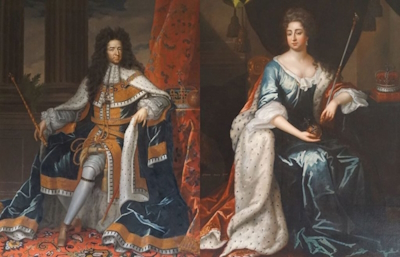 The Nine Years’ War, which took place from 1688-1697, was also known as the war of the Grand Alliance, or King William’s War in the Americas. The Grand Alliance was formed by England, the Dutch Republic, and the Grand Duchy of Austria, later to be joined by others, including Spain and Savoy, to oppose Louis XIV’s expansionism on the Rhine and in northern Italy. Louis XIV’s anti-protestant policies, in particular the persecution of the French Huguenots, also made him unpopular with protestant rulers in Europe. This war also sometimes mistakenly referred to as the War of the League of Augsburg after the coalition formed in 1686 by Emperor Leopold I, the kings of Sweden and Spain, and the electors of Bavaria, Saxony, and the Palatinate against the increasing French threat. Louis XIV also made himself unpopular in England by lending his support to the Jacobite cause of the deposed James II of England, attempting to instigate a Catholic crusade to restore James to the throne. Although fighting was mainly concentrated in Europe, the war spread to colonial possessions in the Americas, India, and West Africa.
The Nine Years’ War, which took place from 1688-1697, was also known as the war of the Grand Alliance, or King William’s War in the Americas. The Grand Alliance was formed by England, the Dutch Republic, and the Grand Duchy of Austria, later to be joined by others, including Spain and Savoy, to oppose Louis XIV’s expansionism on the Rhine and in northern Italy. Louis XIV’s anti-protestant policies, in particular the persecution of the French Huguenots, also made him unpopular with protestant rulers in Europe. This war also sometimes mistakenly referred to as the War of the League of Augsburg after the coalition formed in 1686 by Emperor Leopold I, the kings of Sweden and Spain, and the electors of Bavaria, Saxony, and the Palatinate against the increasing French threat. Louis XIV also made himself unpopular in England by lending his support to the Jacobite cause of the deposed James II of England, attempting to instigate a Catholic crusade to restore James to the throne. Although fighting was mainly concentrated in Europe, the war spread to colonial possessions in the Americas, India, and West Africa.
The outbreak of war
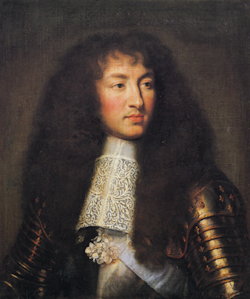 At the onset of the war the French military engineer and Marshal of France, Vauban, was tasked with constructing a system of impregnable fortresses along the frontier to keep France’s enemies out, while at the same time Louis XIV adopted an offensive strategy. In September 1688, Louis led an army of 30,000 men across the Rhine seizing several key cities, which gave him control of the Rhine from Mainz to the Swiss border. The north German princes promptly assembled a force to take back the conquered territories. The French had not expected such a quick reaction and pulled back, destroying as many as 20 cities while employing a scorched earth policy as they withdrew. Meanwhile, the Catholic James II of England had been replaced by William III in November 1688, during what was called the Glorious Revolution, which brought England into the Grand Alliance, especially after Louis offered his support to the deposed James II and his Jacobite supporters. The Holy Roman Emperor, Leopold I, and the Imperial Diet officially declared war on France on 11th February 1689, joining the Grand Alliance once troops had been freed for deployment in the west after successes against the Turks in the east. A united German effort succeeded in taking back the lost Rhineland territories. In March 1689, William III had to contend with a Jacobite rising in Ireland supported by 6000 French troops. The Jacobites initially managed to take over most of Ireland and won an astounding victory at Killikrankie in July 1689, but were eventually decisively defeated at the the Battle of the Boyne in July 1690, releasing troops for deployment in the Low Countries. A few days after William’s success, the French won a significant naval victory at Beachy Head against the English and the Dutch, giving them control of the English Channel. Spain declared War on France in April 1690, as did the Duke of Savoy in June of the same year in an attempt to escape the French sphere of influence.
At the onset of the war the French military engineer and Marshal of France, Vauban, was tasked with constructing a system of impregnable fortresses along the frontier to keep France’s enemies out, while at the same time Louis XIV adopted an offensive strategy. In September 1688, Louis led an army of 30,000 men across the Rhine seizing several key cities, which gave him control of the Rhine from Mainz to the Swiss border. The north German princes promptly assembled a force to take back the conquered territories. The French had not expected such a quick reaction and pulled back, destroying as many as 20 cities while employing a scorched earth policy as they withdrew. Meanwhile, the Catholic James II of England had been replaced by William III in November 1688, during what was called the Glorious Revolution, which brought England into the Grand Alliance, especially after Louis offered his support to the deposed James II and his Jacobite supporters. The Holy Roman Emperor, Leopold I, and the Imperial Diet officially declared war on France on 11th February 1689, joining the Grand Alliance once troops had been freed for deployment in the west after successes against the Turks in the east. A united German effort succeeded in taking back the lost Rhineland territories. In March 1689, William III had to contend with a Jacobite rising in Ireland supported by 6000 French troops. The Jacobites initially managed to take over most of Ireland and won an astounding victory at Killikrankie in July 1689, but were eventually decisively defeated at the the Battle of the Boyne in July 1690, releasing troops for deployment in the Low Countries. A few days after William’s success, the French won a significant naval victory at Beachy Head against the English and the Dutch, giving them control of the English Channel. Spain declared War on France in April 1690, as did the Duke of Savoy in June of the same year in an attempt to escape the French sphere of influence.
The war from 1688 to 1692
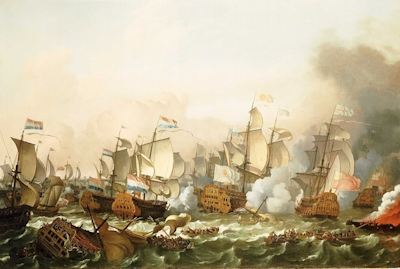 In May of 1689, a French army marched into the Spanish Netherlands, where it was defeated on 25th August at the Battle of Warcourt by an allied army under the Prince of Waldeck, but on 1st July of the following year, a French army under Marshal Luxembourg defeated the allies at the Battle of Fleurus. Meanwhile, the situation deteriorated on the Rhine after Emperor Leopold was forced to withdraw troops to the east after an unexpected Turkish victory on the Danube. Meanwhile in Catalonia, the French played a significant part in igniting a peasant revolt against King Charles II of Spain, using this distraction to capture the town of Camprodon, but were then forced to withdraw when the Spanish sent a large army under the Duke of Villahermosa. While this was happening, the Louis’s forces seized most of Savoy and, by the end of the year, the French seemed to have the upper hand. Louis XIV then hatched plans to invade England in order to depose William and restore James II to the throne, but first needed to sign peace with the Dutch, which he hoped to achieve by capturing the fortress of Namur and employing it as a bargaining chip. Meanwhile, on the other side of the world a French fleet made a failed attack on the Anglo-Dutch fleet stationed in Madras, India, widening the scope of the war. Back in Europe, Allied forces prevented the French from capturing Liège, but were forced to retreat when French reinforcements arrived. In May 1692, an English and Dutch fleet defeated the French at a six-day engagement near the Cherbourg peninsula at the Battle of Barfleur, giving the Alliance dominance of the English Channel. In August, the French regained the upper hand in the Rhineland but suffered setbacks against Savoy in northern Italy.
In May of 1689, a French army marched into the Spanish Netherlands, where it was defeated on 25th August at the Battle of Warcourt by an allied army under the Prince of Waldeck, but on 1st July of the following year, a French army under Marshal Luxembourg defeated the allies at the Battle of Fleurus. Meanwhile, the situation deteriorated on the Rhine after Emperor Leopold was forced to withdraw troops to the east after an unexpected Turkish victory on the Danube. Meanwhile in Catalonia, the French played a significant part in igniting a peasant revolt against King Charles II of Spain, using this distraction to capture the town of Camprodon, but were then forced to withdraw when the Spanish sent a large army under the Duke of Villahermosa. While this was happening, the Louis’s forces seized most of Savoy and, by the end of the year, the French seemed to have the upper hand. Louis XIV then hatched plans to invade England in order to depose William and restore James II to the throne, but first needed to sign peace with the Dutch, which he hoped to achieve by capturing the fortress of Namur and employing it as a bargaining chip. Meanwhile, on the other side of the world a French fleet made a failed attack on the Anglo-Dutch fleet stationed in Madras, India, widening the scope of the war. Back in Europe, Allied forces prevented the French from capturing Liège, but were forced to retreat when French reinforcements arrived. In May 1692, an English and Dutch fleet defeated the French at a six-day engagement near the Cherbourg peninsula at the Battle of Barfleur, giving the Alliance dominance of the English Channel. In August, the French regained the upper hand in the Rhineland but suffered setbacks against Savoy in northern Italy.
The war from 1693 to 1697
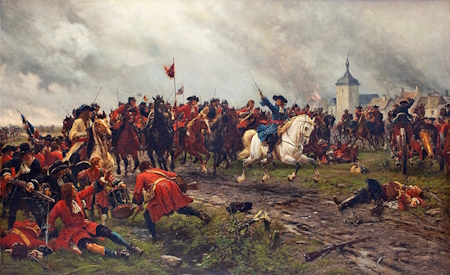 In 1693, Louis XIV, despite the costly victory over the Grand Alliance in July at the Battle of Neerwinden, also known as the Battle of Landen, was facing an economic crisis caused by the costs of fielding an army of over 400,000 men, which, together with a famine, caused widespread death and hardship in France. Additionally, a Dutch expedition to India overwhelmed the French garrison at Pondichéry in the south of the country. Despite these setbacks, Louis intensified his campaigns in the Netherlands, northern Italy, and the Rhineland with some initial successes, such as the resounding victory over the Duke of Savoy at the Battle of Marsaglia on 4th October 1693, and the successful attack on an allied merchant convoy heading for the Mediterranean near Lagos Bay. In 1694, the French war effort came to a standstill, except in Catalonia, where Louis’s army defeated Spanish forces under the Marquis of Escalona at the Battle of Torroella, opening the way to Barcelona. The Spanish would have then signed peace treaty with the French, had not the Alliance sent aid in the form of a fleet, which forced the French fleet to withdraw. After the arrival of allied ships, the French fleet played little further part in the war, instead relying heavily on privateers such as Jean Bart to attack allied commerce. As a result, the allied fleet was free to bombard French ports, such as St. Malo and Calais. In 1695, the French suffered several other setbacks, including the death of France’s leading general the Duke de Luxembourg and the loss of the fortress at Namur.
In 1693, Louis XIV, despite the costly victory over the Grand Alliance in July at the Battle of Neerwinden, also known as the Battle of Landen, was facing an economic crisis caused by the costs of fielding an army of over 400,000 men, which, together with a famine, caused widespread death and hardship in France. Additionally, a Dutch expedition to India overwhelmed the French garrison at Pondichéry in the south of the country. Despite these setbacks, Louis intensified his campaigns in the Netherlands, northern Italy, and the Rhineland with some initial successes, such as the resounding victory over the Duke of Savoy at the Battle of Marsaglia on 4th October 1693, and the successful attack on an allied merchant convoy heading for the Mediterranean near Lagos Bay. In 1694, the French war effort came to a standstill, except in Catalonia, where Louis’s army defeated Spanish forces under the Marquis of Escalona at the Battle of Torroella, opening the way to Barcelona. The Spanish would have then signed peace treaty with the French, had not the Alliance sent aid in the form of a fleet, which forced the French fleet to withdraw. After the arrival of allied ships, the French fleet played little further part in the war, instead relying heavily on privateers such as Jean Bart to attack allied commerce. As a result, the allied fleet was free to bombard French ports, such as St. Malo and Calais. In 1695, the French suffered several other setbacks, including the death of France’s leading general the Duke de Luxembourg and the loss of the fortress at Namur.
An end to the war in sight
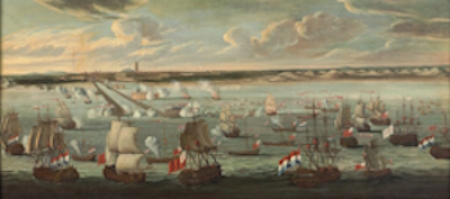 The balance of power was starting to turn against the French with their forces in Spain, in the Rhineland, and in the Low Countries barely able to hold their own. On the Italian front, the French attempted to negotiate peace with Victor Amadeus, the Duke of Savoy, who now feared the expanding power of the Holy Roman Empire more than that of the French. Peace was formalised by the Treaty of Turin on 29th August 1696. In the winter of 1695–1696, Louis realised the war had deteriorated into one of attrition that he couldn’t win, but William still wanted a decisive victory before signing peace. It didn’t help that Louis was reluctant to recognize William as the rightful King of England. With the continual disruption of trade and commerce, politicians from England and the Dutch Republic, desirous for an end to the war, pushed for peace. France and the Holy Roman Empire were now both economically exhausted, and after some continued fighting in the Spanish Netherlands and Catalonia, peace was finally signed at the treaty of Ryswick on 20th September 1697.
The balance of power was starting to turn against the French with their forces in Spain, in the Rhineland, and in the Low Countries barely able to hold their own. On the Italian front, the French attempted to negotiate peace with Victor Amadeus, the Duke of Savoy, who now feared the expanding power of the Holy Roman Empire more than that of the French. Peace was formalised by the Treaty of Turin on 29th August 1696. In the winter of 1695–1696, Louis realised the war had deteriorated into one of attrition that he couldn’t win, but William still wanted a decisive victory before signing peace. It didn’t help that Louis was reluctant to recognize William as the rightful King of England. With the continual disruption of trade and commerce, politicians from England and the Dutch Republic, desirous for an end to the war, pushed for peace. France and the Holy Roman Empire were now both economically exhausted, and after some continued fighting in the Spanish Netherlands and Catalonia, peace was finally signed at the treaty of Ryswick on 20th September 1697.
Peace and its aftermath
Under the terms of the 1697 Peace of Ryswick, French control over the entirety of Alsace was officially recognized, but Lorraine and all gains on the right bank of the Rhine were relinquished and restored to their original rulers. The French also evacuated Catalonia and the Spanish Netherlands. Louis XIV finally recognised William III as the rightful king of England, and an end was put to militant Jacobinism for the time being. The Dutch acquired several barrier fortresses in the Spanish Netherlands to help secure their borders and they were additionally granted a favourable commercial treaty with France. In the Caribbean, both France and Britain kept control of their pre-war colonies and continued to share St. Kitts, while French control over the western part of Hispaniola was officially recognized. England discovered a greater need for an effective military presence in the West Indies to protect their colonies. Although the war was now at an end, all sides viewed the peace as just a pause in hostilities, since it failed to resolve who would succeed the ailing and childless Charles II of Spain as ruler of the Spanish Empire, a question that had dominated European politics for over 30 years. This would lead to the devasating the War of the Spanish Succession in 1701.
